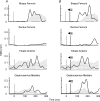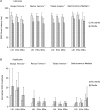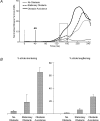The effects of an auditory startle on obstacle avoidance during walking
- PMID: 18653659
- PMCID: PMC2614017
- DOI: 10.1113/jphysiol.2008.156042
The effects of an auditory startle on obstacle avoidance during walking
Abstract
Movement execution is speeded up when a startle auditory stimulus is applied with an imperative signal in a simple reaction time task experiment, a phenomenon described as StartReact. The effect has been recently observed in a step adjustment task requiring fast selection of specific movements in a choice reaction time task. Therefore, we hypothesized that inducing a StartReact effect may be beneficial in obstacle avoidance under time pressure, when subjects have to perform fast gait adjustments. Twelve healthy young adults walked on a treadmill and obstacles were released in specific moments of the step cycle. On average the EMG onset latency in the biceps femoris shortened by 20% while amplitude increased by 50%, in trials in which an auditory startle accompanied obstacle avoidance. The presentation of a startle increased the probability of using a long step strategy, enlarged stride length modifications and resulted in higher success rates, to avoid the obstacle. We also examined the effects of the startle in a condition in which the obstacle was not present in comparison to a condition in which the obstacle was visibly present but it did not fall. In the latter condition, the obstacle avoidance reaction occurred with a similar latency but smaller amplitude as in trials in which the obstacle was actually released. Our results suggest that the motor programmes used for obstacle avoidance are probably stored at subcortical structures. The release of these motor programmes by a startling auditory stimulus may combine intersensory facilitation and the StartReact effect.
Figures





References
-
- Carlsen AN, Chua R, Inglis JT, Sanderson DJ, Franks IM. Startle response is dishabituated during a reaction time task. Exp Brain Res. 2003;152:510–518. - PubMed
-
- Carlsen AN, Chua R, Inglis JT, Sanderson DJ, Franks IM. Can prepared responses be stored subcortically? Exp Brain Res. 2004a;159:301–309. - PubMed
-
- Carlsen AN, Chua R, Inglis JT, Sanderson DJ, Franks IM. Prepared movements are elicited by startle. J Mot Behav. 2004b;36:253–264. - PubMed
-
- Castellote JM, Kumru H, Queralt A, Valls-Solé J. A startle speeds up the execution of externally guided saccades. Exp Brain Res. 2007;177:129–136. - PubMed
-
- Chen HC, Ashton-Miller JA, Alexander NB, Schultz AB. Age effects on strategies to avoid obstacles. Gait Posture. 1994;2:139–146.
Publication types
MeSH terms
LinkOut - more resources
Full Text Sources

